Estonia – Coastal (Tallinn, Pärnu, Rapla, Rakvere, Narva) July 7-9, 2019
I continued my drive from south Estonia seeing a number of castles and manor houses on my way to Narva.
Paide Castle (Paide Castle of Order – Pade ordulinnuse varemed ja Vallitorn), Paide. Originally a Livonian castle built in 1266, the 35m-high 6-story keep (with walls 4.25m thick) remains. It was strengthened with towers and outer bastions and was involved in the Livonian Wars in 1573 when Russian troops occupied it and in the 1600-11 Polish-Swedish war. The tower was rebuilt in 1895. In 1941, Soviet troops blew up the central tower and it was not repaired until 1993 and is now the Jarva County Museum.
Kiltsi Castle (Schloss Ass or Gilsenhof), Kiltsi. Originally a 14th-century castle, a manor house was built within the castle walls in the 1780s. It was owned by the famed explorer and scholar Adam von Krusenstern and was in the family until the early 20th century. Three generations of seamen-cartographers Krusenterrns (from father to grandson) participated in mapping the Pacific Ocean, the Arctic Ocean the Gulf of Finland and the Retshora River basin. Admiral Adam Johann von Krusenstern charted his scientific masterpiece, the Atlas of the Pacific Ocean, in Kiltsi Castle. In Russia, he is best known for organizing and leading the first Russian sailing trip around the world. His huge personal library in the Castle, one of the oldest in the Baltic countries included hundreds of maps and atlases. Since 1920, it has been a school. It was its biggest in the early 1950s with more than 200 pupils. It still functions as a school organizing creative art and handicraft workshops and training tour guides. It was restored in 2008-10.
The yellow-with-white trim building is a lovely semi-circular shape with a central large building and porticoed corridors leading to buildings at the end.
Vao Tower-Fortress, Vao. This tower/fortress dates from the 1440s but never saw military operations as deduced by the thickness of the walls. It was built in the 14th century of local limestone to 4 stories with the 2nd floor being the living quarters of the lord (with a latrine, chapel, bed alcove and fireplace) and the top floor had a purely defensive purpose. It was constructed to keep control in areas where large strongholds were not needed. In the 1770s the tower was no longer used as a manor and a new manor house were built then. The limestone castle was renovated in 1986 with new painted glass windows installed.
There is a large equestrian ring nearby and a competition was just about to start the day I was there.
It was 150kms to Narva from Vao on good roads.
NARVA (pop 59,000)
On the Narva River that forms the Estonian/Russian border at the extreme eastern point of Estonia, it is 200 km from Tallinn and 130 km from St Petersburg. The mouth of the Narva River on the Gulf of Finland is 13 km downstream.
History. It was originally settled in the 5th millennium BC and a fortified settlement dates to 1000 BC, the oldest in Estonia. Located at the crossing of trade routes, the castle dates to 1277 with a surrounding town. In 1492, Ivangorod Fortress was built across the Narva River by Ivan III of Moscow. Due to opposition from Tallinn, it remained a small town. Russia occupied it from 1558-81 and Sweden from 1581-1704 who built the Old Town and a complete set of bastions built. After a fire in 1659, only stone buildings were allowed and with income from active trade, it was completely rebuilt in two decades. Russia conquered the city in 1704.
Since the 19th century, Narva has been an industrial city using cheap power from the powerful Narva waterfalls. At the end of the 19th century, one of the largest cotton mills in Europe with 10,000 workers was built and Narva was the leading industrial town in Estonia.
With a public referendum in 1917, Narva citizens voted to become part of Estonia. In WW II, the city remained relatively intact until 1944 when Soviet air raids destroyed 98% of the baroque Old Town. In the early 1950s, Soviet authorities demolished the ruins to make way for apartment buildings. Only three buildings remain of the Old Town.
After the war, the original citizens (who had been completely evacuated by the Germans) were not allowed to return and Russians immigrated to populate the city.
Now 95.7% of the population are native Russian speakers and 88% are ethnic Russians. . 47% are Estonian citizens, 36% are Russian and 15% are undefined.
1.2% of the population had HIV in 2012 with more than 1,600 cases.
Alexander’s Cathedral. An evangelical Lutheran church, it was built from 1881-84 for the workers of the Krenhom Manufacturing Company and given cathedral status in 2000. In 1944, the bell tower was destroyed. About 10m of the tower is old brick and the other 40+m are new stone. The church went bankrupt in 2015 related to renovations and was purchased by the Estonian government and the Lutheran church.
A light installation, “Heaven Above Narva” about the colourful history of Narva is displayed on the church vaults seen from special chairs. It is the largest permanent projection area in Eastern Europe at 520m2. The dome is 25.5m high and the bell tower is 61m high.
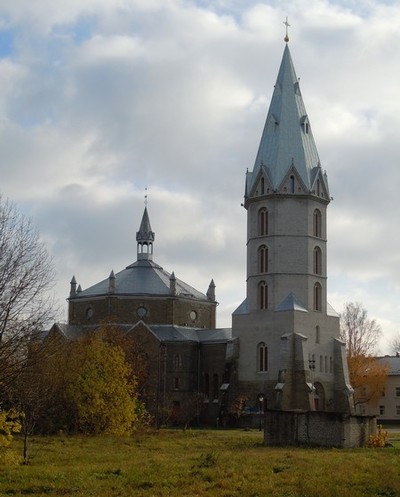
I entered on a Sunday morning at 10:30 and it was empty with a large central rib vaulted dome. There are no pews only many slightly reclining chairs surrounding the octagonal interior. Balconies and wood walkways above are in five of the side half domes. Nice round stained glass windows are at the top of each of the 8 arches. Most of the plaster is gone and the dirty brick is exposed. It doesn’t appear to be actively used although a service was on the loudspeakers and nobody else arrived while I was there. On leaving I noticed that there was a man and an organist in the 2nd level of the bell tower (maybe that is where services are held?).
Resurrection of Christ Cathedral. This Estonian Orthodox cathedral was built between 1890-96 and was the only building standing after the bombing of the city in 1944. It was renovated on its centenary. The façade is cream and dark red patterned brick with decorative arches over the window and domes. It is neo-Byzantine on a Greek cross plan with a square centre and four equal arms. The walls and dome are brick and the stairways Finnish granite. It can accommodate 2000 and the bell tower is 28.8m high. The ornate 3-part gilt iconostasis has a crucifix dating from the 17th century and the murals in the dome and upper corners were painted in 1912.

I came during the Sunday morning service. The congregation was mostly old women in their head scarves.
Hermann Castle. The original wooden stronghold was built by the Danes in the 13th century and the first stone fortress was built in the 15th century and surrounded by a 1km town wall with 7 towers and a moat that was removed in the 1770s. Its 51m-high Long Hermann tower dominates the river.
A moated stonewall faces the city, The centre is a large grass field and a large square building and the high keep faces the river. The impressive Ivangorod Fortress across the river is palpably close. Free
Estonian customs control to cross into Russia is immediately next to the fort.
Narva Art Gallery, The pre-war collection has 3 parts: the collection from the House of Peter I with art from the 17-18th centuries, the collection of Sergei Lavretosov (1824-1906) from the 2nd half of the 19th and beginning of the 20th century and purchases made by the museum. WW II resulted in significant losses. Textiles from the Kreenholm factory – very dated patterns. €3, no reduction
Narva-Jõesuu beach. About 15 km north of Narva on the Gulf of Finland, this fine golden sand beach goes forever west from the Narva River mouth. Don’t bother parking in the town as several paths lead from the highway down to the water. There are an endless number of places to camp for free – on the beach in the beach grass or in the forest. I have no idea what the water temperature would be in the summer but I imagine it would not be a comfortable swim.
Baltic Klint. A tentative WHS (06/01/2004), this is an erosional limestone escarpment that runs 1200kms from Gotland and Oland Islands in Sweden through Estonia and ends south of Lake Ladoga in Russia where it disappears under younger sedimentary deposits.
The Estonian section is on the islands of Osmussaar and Suur-Pakri and then runs along the southern shore of the Gulf of Finland. The cliff reaches its highest level of 55.6m above sea level at Ontika in Estonia, part of a 23km long uninterrupted cliff that runs between Suka and Toila. Only the top 2-15m of the cliff is limestone.
Three waterfalls form on the klint. The highest is Veleste Waterfall with a 25m drop, the highest in Estonia. Descend on a new switchbacking staircase that descends the cliff for good views of the waterfall down. The waterfall didn’t have much water at this time of year.
The Klint is cut by several rivers (the Narva, Luga, Izhora and the Tosna in Estonia) and waterfalls and rapids form.
In Oland and Gotland, the klint forms a series of sea stacks known as rauks. The most stacks can be seen at Faro in northern Gotland and Byrum in NW Oland. Some of the stacks may not be related to the klint.
Google Maps took me to the most depressing set of Soviet-era apartment buildings the “Baltic Klint”. It is amazing what she does sometimes.
RAKVERE
Estonian Police Museum. Behind the police station, it tells the history of the Estonian police forces since its inception in 1918 and nationalization in 1919. After 5 police were killed in a Soviet coup d’etat in 1925, it was thoroughly modernized and a police school opened. The Soviets disbanded it in 1940 and most policemen were repressed. The national force was reformed in 1990, had many growing pains and joined with the Estonian Border Guard to from the Estonian Police and Border Guard in 2010. See uniforms, weapons and some vignettes of some criminals. €7, 6 reduced
Rakvere Castle. On Vallimägi hill, the original wood fort dated to the 5th century and the Danes built a fieldstone fort in the middle 13th century. They were replaced by the German (Livonian) Order in the 14th-16th centuries which built a convent new defence walls and a tower still present today using slate. Expansions continued until it was destroyed in the Polish-Swedish war in 1602-05. The first preservation started in 1901and in 1988 it was opened as a museum. Along with Tallinn and Narva, it formed the major defence of north Estonia.
In the courtyard, see canons, archery, workshops, and a red light district. The convent has the history of the area and castle, swords, a torture chamber and exhibitions on science and astronomy. €11, 9 reduced
Aaspere Manor Windmill, Aaspere. The manor was built in 1800 in a neoclassical style and damaged by fire in 1966. It is presently abandoned and surrounded by the park.
You get a prize if you find the windmill that is almost exactly 3 km north of the manor on the other side of the highway (and can be easily seen from the highway). It is a wonderful-looking mill – round and tapering to the restored rotating top. It has vanes and a large millstone outside but can’t be entered.

Lahemaa National Park. Founded in 1971, the park is 70 km east of Tallinn with the Gulf of Finland on the north. Its 750 km2 includes 251 km2 of sea and is the largest park in Estonia with four large peninsulas separated by four bays. It has stony and sandy seashores, bogs, pine and cliff forests covering 70% of the park, rivers that cut the limestone layers and erratic rocks left from the last Ice Age. Several trails go through the park. Boar, red deer wolves, bear and lynx can be seen. The Baltic Klint (overlain by sediment) divides the park into two zones. Unlike Canadian national parks, there are many farms and some lovely houses throughout the park.
There are four manors in the park: Palmse, Vihula, Kolga and Sagadi and the Haro submarine base.
The park visitors center and museum are at Palmse Manor. Zero English.
Palmse Manor and Open-Air Museum, Vihula. From 1287-1510, the manor grew grain, rye and barley and provisioned the Tallinn Cistercian Nunnery. The Metztacken Family owned it from 1522-1677. After it was destroyed in the Livonian War and rebuilt, it controlled 21 ploughlands and fishing on the sea and lakes. The von der Pahlen family continued construction after the Great Famine of 1695-7, the Great Northern War, the plague killed 229 and continued until the mid-1700s when there were 20 buildings. Distilling vodka was a main business and a brick kiln was built in 1868. The manor owned 10,000ha, had 900 peasants and a dairy, weavers and limestone quarry. It was nationalized in 1923. After WW II, it was a Pioneer camp. It was restored in 1975-85 and opened to the public.
The open-air museum shows the distillery, greenhouse, barn, pavilions and a bathhouse. The house is furnished with period 19th-century furniture, virtually none original, but is quite lovely inside with wood plank floors on the 2nd story and grand ceramic heaters.
The 210ha park has a French garden, an English garden with a maze and 2 short hiking trails in the woods. €9, no senior reduction
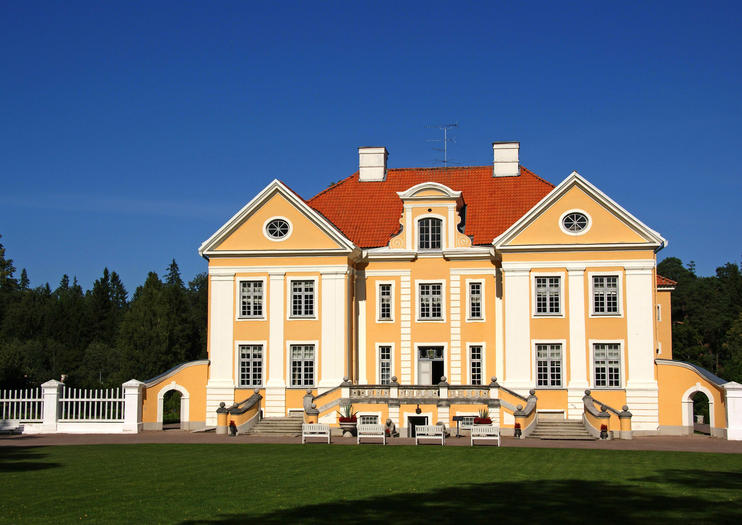
Viinistu Art Museum, Viinistu. In an old industrial fish processing plant on the water, this is a collection of 600 paintings by Estonian artists collected by one man. It covers a wide range of art but I loved some of the work: Eduard Wiiralt (1898-1954), Rein Tammik ((1947-), Ants Vildalepp (1921-2012) and Aleksander Krims Radava (1893-1947). Outside is a collection of “100 Suitcases” – concrete suitcases with the baggage tags of John Smith and various cities around the world (including Ottawa Canada). €5, 3 reduction
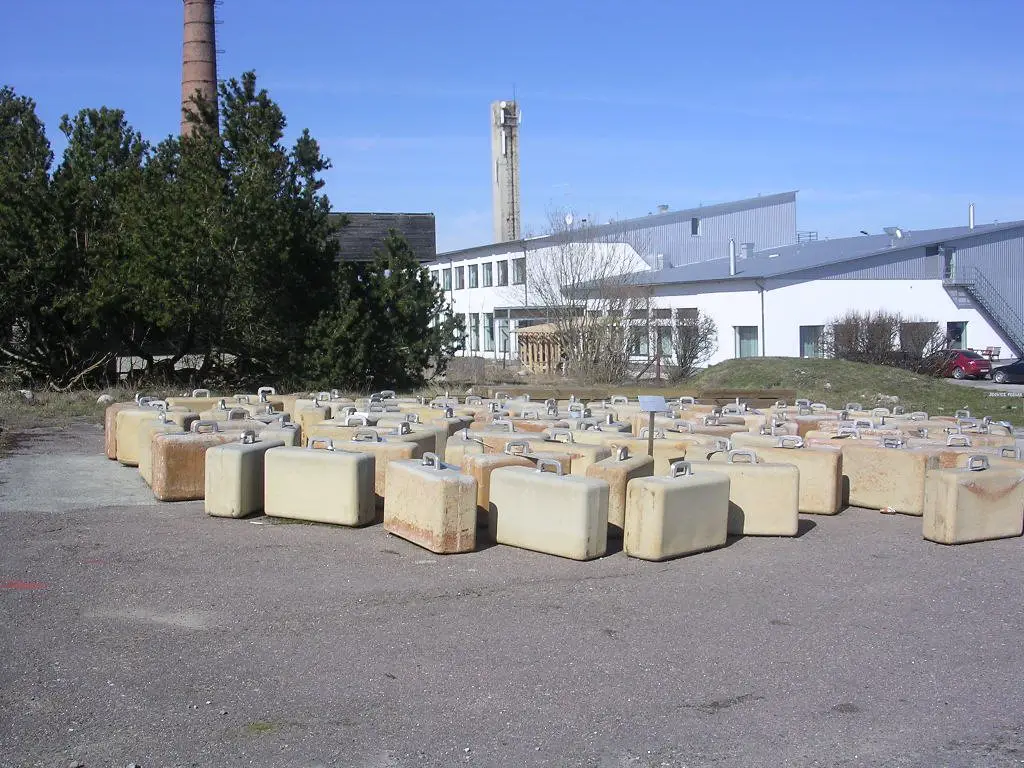

Hara Old Submarine Base. In the NM “The Dark Side” series, this is an abandoned Soviet submarine base 65 km east of Tallinn on the Juminda Peninsula (part of Lahemaa National Park). It was built between 1956-58 as a top-secret base and 5 villages were relocated to build it including miles of stone walls. It was used while they occupied Estonia and abandoned in a hurry in 1991 with Estonian independence. Hundreds worked at the facility, one of only 3 in the world sophisticated enough to demagnetize submarines. Hulls of submarines and warships acquire a magnetic field over time that makes them easier to detect on radar and more susceptible to naval mines. At peak operation, cables stretched 20 km out to sea as a measuring system. The entire bay was protected by wires and sensors.
It has fallen into disrepair and while the concrete foundations remain, the buildings have been gutted. It was pillaged for anything that could be reused or turned into cash (scrap metal etc.) The pier-like ruins have been invaded by urban explorers and is covered in graffiti art. Unless you have access to a boat, only about 10% of it is accessible. Drive 1.3 km down a paved track to the parking lot. This is not worth paying for. Warning signs say that you should not walk on the pier which is all there is to see. It has the shells of concrete buildings on it.
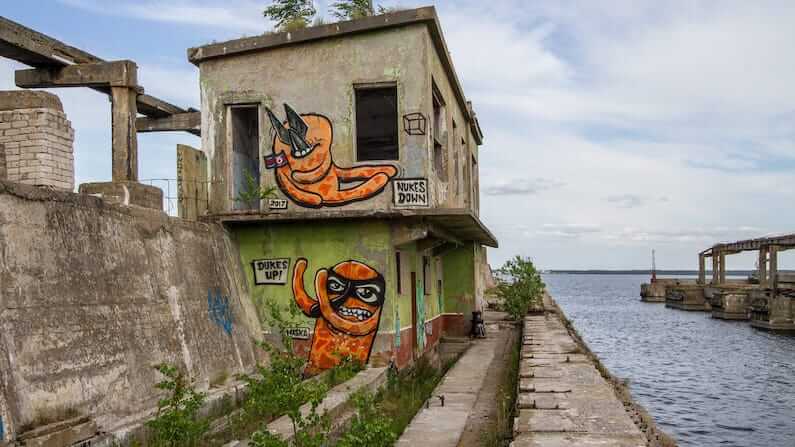
A company called Hara Sadam is planning on turning it into a heritage site and rehabilitating the harbour and there is a €5 fee for visiting, €3 reduction
Wooded Meadows. A tentative WHS (06/01/2004), two of the 8 meadows listed in Estonia were between the coast and the highway east of Tallinn – Allika and Mäepea.
Wooded meadows were common in medieval Europe, especially around the Baltic Sea but have largely disappeared. The best examples that remain are in Estonia. They consist of sparse natural stands of deciduous trees and shrubs distributed in irregular patches. Regular mowing of the tree layer, cutting of trees, collection of branches and twigs for cattle and sheep fodder and grazing are an important part of their formation. Mowing by scythe from about 2000 years ago gave them their typical form. Due to breaks in regular mowing, there is a continuum of successional stages between wooded meadows and forests. The maximum distribution in Estonia was between the 18th century and the 1940s. when they covered almost 19% of Estonia’s surface area. They have decreased because of the reduction of land use during the war, cessation of hand mowing and cessation of mowing by horses. The first to disappear were wet wooded meadows, of which no preserved examples exist. There are more in Estonia as there were more collective farms and farmers kept small numbers of animals for their use for whom hay was made by hand or by horse. This changed rapidly in the 1960s.
Most of the remaining wooded meadows are less than 5ha. In 1995 about 200ha of wooded meadow was mown but less now because of the cessation of cattle raising and the high age of the people who lived there.
69% of Saaremaa was covered in wooded meadows before WW II, but less than 50ha were mown in recent years. Hiiumaa has only 30ha of wooded meadow remaining. On the mainland, Läänemaa has 200ha of wooded meadow of which 50ha has been mown in recent years. Raplamaa has 160ha with 80ha mown. Pärnumaa has 200ha with 50ha still mown.
They have high species richness. Some of the Estonian ones have world record species densities of up to 76 species of vascular plants per m2. They are also great bird-watching areas.
Allika and Mäepea are two meadows on my way to Tallinn. I drove through the rural countryside but the specific area included in the WHS listing is not marked. There were many uncultivated small areas with trees/bushes and meadows full of flowers.
Kiiu castle (tower), Kiiu. This is a lovely small round stone tower with a red conical roof and an added wood “walkway” built onto it ⅔ of the way up. It is covered in ivy. It was built by a German farmer in 1517 to live in during dangerous times after which he moved back into the wood houses of the farm. The tower was in ruins and restored in 1975 when the balcony was added. It has 3 floors above the ground floor furnished with tables. The balcony is on the 3rd floor. I was given a lovely talk by the elderly woman who runs it as a business. She was an agronomist and her husband was a mechanic they needed to find other work after independence in 1991 so opened a small coffee shop on the bottom floor in 1992. The other three floors were used for parties. It is closed from November – April as it is too expensive to heat in the winter. She sells a liqueur made from eggs “Kiiu Torn” and I bought a small bottle of rum/chocolate for €11. She was very sweet and spoke good English. €1

Jägala Waterfall. This falls 8m over the Baltic Klint, a limestone layer formed over 9 million years 500 million years ago (see Baltic Klint above). In high water the waterfall is 70m wide. It forms a lovely wide crescent on top of the flat limestone. The soft sandstone underneath is undercut forming a cave. The waterfall recedes about 20cms per year and a canyon 230m long has formed downstream. A 6m deep deep pool has whirlpools and are dangerous to swim in but there were many swimmers.
Maardu Manor. This is a lovely yellow with white trim 2-story manor house with a park and mature trees in the front. A wall encloses a similar park at the back. There were no signs on the door and no furniture in the entry when I peered through the windows. It appears to not be open to the public.
Museum of Fight for Estonia’s Freedom, Lagedi. On a farm truly in the middle of nowhere SE of Tallinn, this profiles Estonia since 1944 – the German and then the Soviet occupation. It is a military museum with tanks, armoured vehicles, an electrical generator, and a diesel run light with a beam that carried 100 km (used to blind enemy ships) outside. The inside has uniforms, guns and military memorabilia profiling the partisan movement that operated partly out of this farm. Not of much interest as there was no English. €6
VIIMSI
Viimsi Manor. This yellow-with-white trim manor house is supposed to contain the Estonian War Museum and the General Laidoner Museum but it was empty.
Viimsi Open Air Museum. On the water northeast of Tallinn, this is small with a “farm section” with 3 thatched logs and stone and one shingled building. The fishing part has a few small buildings. €3, 2 reduced
TALLINN (pop 435,000)
Tallinn is the capital, primate and the most populous city of Estonia. Located in the northern part of the country, on the shore of the Gulf of Finland of the Baltic Sea, Tallinn is a major financial, industrial, cultural, educational and research centre of Estonia. Tallinn is located 80 kilometres (50 mi) south of Helsinki, Finland, 320 kilometres (200 mi) west of Saint Petersburg, Russia, and 380 kilometres (240 mi) east of Stockholm, Sweden. It has close historical ties with these three cities. From the 13th century until the first half of the 20th century Tallinn was known in most of the world by its historical German name Reval.
Tallinn, first mentioned in 1219, received city rights in 1248, but the earliest human settlements date back 5,000 years. The first recorded claim over the land was laid by Denmark in 1219, after a successful raid of Lyndanisse led by King Valdemar II, followed by a period of alternating Scandinavian and Teutonic rulers. Due to its strategic location, the city became a major trade hub, especially from the 14th to the 16th century, when it grew in importance as part of the Hanseatic League. Tallinn’s Old Town is one of the best-preserved medieval cities in Europe and is listed as a UNESCO World Heritage Site.
Tallinn has the highest number of startups per person among European countries and is the birthplace of many international high-technology companies, including Skype and Transferwise. The city is to house the headquarters of the European Union’s IT agency. Providing to the global cybersecurity it is the home to the NATO Cyber Defence Centre of Excellence. Tallinn is ranked as a global city and has been listed among the top ten digital cities in the world. The city was a European Capital of Culture in 2011, along with Turku in Finland. See Tallinn.
Tallinn Botanic Garden. On the far east of the city closer to Viimsi, there is a palm house, woody plants and mostly mature trees and shrubs form the core of this garden. It showcases Estonian plants suited to this short growing season. €5, 3 reduced
Fahle Apartment and Office Building (Fahle Maja) In the NM “Modern Architecture Buildings”, this is dirty white limestone 5-story building with a modern 5-story glass extension on top. Stores and the Fahle restaurant are on the ground floor.
The building is part of a complex of a former cellulose and paper factory that got its name from Emil Fahle (1875-1929), one of the most influential businessmen of the early 20th century in Tallinn. It has become the city’s first large-scale example of industrial rebirth, with lofts, restaurants, clubs and towering over all this, a new glass box with apartments. It is symptomatic of the current frantic building boom in Tallinn, of the rampant daring of developers, of attempts by real-estate sharks to capture market trends and to sell the kudos and added value of an entire living environment.
A group of young architects wanted to create a space for living, creating and consuming, in the tall and voluminous boiler house (1926) built from limestone. The addition of the glass top floors was controversial from a heritage point of view.
Studios and galleries were supposed to take up residence in the complex, but today, none of the original candidates has moved in, only an art gallery and a television station.

Glehn Park. In this huge park near Glehn Castle are some weird sculptures made of rough rock and cement: a “house” with an odd arched roof, an alligator with a red tongue, a horned man with a thick stick and one figure that has fractured at the legs and fallen
over.

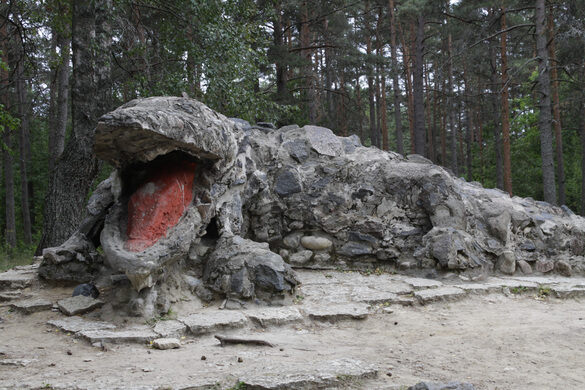
Kristiine Centre. In south Tallinn, this is a large box shopping mall with no special features.
With a ferry to Helsinki to catch at 18:30, I had a busy walk-about through the Old Town seeing these sites in order. I found a great free parking spot next to Linda Park and the fort walls.
TALLINN CARD. This museum card gives free admission to most museums in Tallinn and reduced rates to the one private museum, Tallinn Legends. Available for 24, 48 or 72 hours, there is also the Tallinn Plus card that also includes public transportation. Purchase online or at most hotels, the Tourist Information Center but only at one museum, KUMA. I bought the 24-hour card for €26 and got value from it even though I was eligible for senior rates at most of the museums. Some museums were closed on Tuesdays.
Historic Centre (Old Town) of Tallinn. The Old Town, which is the old Hanseatic town, the “city of the citizens”, was not administratively united with Cathedral Hill until the late 19th century. It was the centre of the medieval trade on which it grew prosperous.
The city of Tallinn has never been razed and pillaged. Although extensively bombed by Soviet air forces during the later stages of World War II, much of the medieval Old Town still retains its charm. The Tallinn Old Town (including Toompea) became a UNESCO World Cultural Heritage site in 1997.
It is very crowded with tourists, especially tour groups. Food is inordinately expensive.
Linda Monument. A former Swedish bastion sat here on Linda Hill Park in 1862. The present small bronze sculpture of a woman sits on a granite block in the middle of five 250-year-old small leaf linden trees. It is a copy of A Weizenberj’s original placed here in commemoration of the mass repressions of the Soviets after 1941. The statue is also the site of August 1992 when a coup was attempted and the road to Toompea was blocked with large stones and concrete blocks.

Toompea Palace. This is the Parliament of Estonia called the Riigikogu. It was built in 1920-22 in the castle courtyard in Expressionist style. Over the centuries the hill has turned from a medieval fortress into a modern centre of government. All that remains of the fort is its western wall and tall Hermann tower.
Around 1050, the first fortress was built on Tallinn Toompea. The Toompea (Domberg) or “Cathedral Hill”, has been for 800 years the seat of the central authority of Estonia: first the Danish captains, then the komturs of the Teutonic Order, and Swedish and Russian governors. It was until 1877 a separate town (Dom zu Reval), the residence of the aristocracy; it is today the seat of the Estonian parliament, government and some embassies and residencies.
A limestone cliff runs through the city. It can be seen at Toompea, Lasnamäe and Astangu. However, Toompea is not a part of the cliff, but a separate hill.
Alexander Nevsky Cathedral. This orthodox cathedral was built between 1894-1900 in Russian Revival style when Estonia was part of the Russian Empire. It is Tallinn’s largest Orthodox cathedral. Saint Alexander Nevsky, in 1242, won the Battle of the Ice on Lake Peipus, in the territorial waters of present-day Estonia.
The cathedral is on the hill of Toompea directly across the street from the parliament buildings. The exterior is richly decorated with a granite base and five onion domes. It has 16 bells with the largest weighing 16 tons.
The interior has 3 altars and three gilded carved wooden iconostases with floral and geometric designs on the great columns and arches and a candy cane strip. The windows in the apse are stained glass. Free
Von Krahli Theater. This is a small performance theatre with a stage, chair seating and a balcony. It has a bar and restaurant.
Tallinn Legends is a theatrical and interactive museum recreating historical events and legends that have contributed to the folklore of medieval Tallinn. It uses a mixture of storytelling, live performances and special effects in 9 separate rooms with 360° themed sets and 7 actors. Events included are the Black Plague, the Execution of Johann von Uexkull and the construction of St. Olaf’s Church. Visitors are escorted by the actors as they move from one room to another and are encouraged to participate in a 40-minute-long show. €16, 9.60 with Tallinn Card
Estonian History Museum. In the Great Guild Hall built in 1410, there is a great video that discusses the entire history of Tallinn with English subtitles. There is a disjointed display of artifacts with several interesting ways of looking at Tallinn. I don’t usually like coin exhibits but this was presented in an interesting way showing how much things cost throughout the ages. The most expensive thing was a suit of chain mail, next was a sword. €8, 6 reduced
Estonian Museum of Applied Design and Art. A collection of Estonian contemporary designs, it displays up to 15.000 pieces of work made of textile art, ceramics, porcelain, leather, glass, jewellery, metalwork, furniture and product design. The temporary exhibit was on Lugenik, a local printer/publisher with books, artists and designers. €5, 4 reduced
St. Olaf’s Church. At the end of the 15th century, a new 159 m (521.65 ft) high Gothic spire was built for St. Olaf’s Church. Between 1549 and 1625 it may have been the tallest building in the world. After several fires and subsequent periods of rebuilding, its overall height is now 123 m. Inside, it is a 3 nave church with plain white walls, wood plank flooring and carved wood pew end. It is still used actively. Free
I climbed the 258 steps on a great spiral staircase to the observation deck just below the towering spire. Great views especially of the harbour and town walls with 5 guard towers. €3
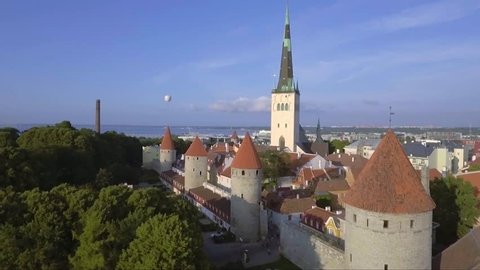
The Estonian Maritime Museum provides a detailed overview of the nation’s seafaring past. This museum is also located in the city’s Old Town, where it occupies one of Tallinn’s former defensive structures – Fat Margaret’s Tower. €5, 4 reduced

Museum of Estonian Architecture. On four floors of this nice old building, the exhibits start with many models of buildings and then profile architecture in Tallinn from the 1920s. There is an odd exhibit on geometry and metaphysics that is more of an art exhibit. The top floor is dedicated to Kindergarten design. €6, 3 reduced
Tallinn Museum of Orders of Knighthood. This is quite an amazing collection of medals and badges from orders created by many governments around the world. But frankly, it gets more than a little boring. Most are not very significant and they all start to look the same after a while. It would have more meaning if some of the famous people who received them were mentioned. €9, 5 reduced
St. Peter and Paul Cathedral. This is the cathedral church of the Roman Catholic Apostolic Administration of Estonia. Catholicism was introduced to Estonia by force via the Northern Crusades and dominated religious life during the Middle Ages. However, following the Reformation during the 16th century, Lutheranism took its place as the dominant faith, and during the time of Swedish rule in Estonia, Catholicism was banned.
Following Sweden’s loss of Estonia to the Russian Empire during the Great Northern War, religious freedom was introduced by the new authorities. In 1799, the Catholic parish had grown large enough to be granted the former refectory of the long-since-closed St. Catherine’s Monastery as a place of worship on the site of the present church. In 1841, designs were made for a proper new church building for the site, which had grown too small. The architect was the well-known St. Petersburg architect Carlo Rossi. He designed a neo-Gothic basilica, without an apse, with a neo-classical exterior. Between 1920 and 1924, the main, western façade received its present look. The cathedral has undergone a series of renovations, the latest in 2002–2003.
The plain white interior has blue columns and a ceiling. The highlight for me was the lino-cut Ways of the Cross in wonderful old wood frames. Free
War of Independence Victory Column. The War of Independence was fought against Soviet Russia in 1918-21. With the help of the navies of Denmark, Great Britain, Finland and Sweden, Estonia was successful in turning back the Russians. The Cross of Liberty, an Estonian military decoration awarded from 1919-25, crowns the top. It is 23.5m high and consists of 143 glass blocks. It was completed in 2009.
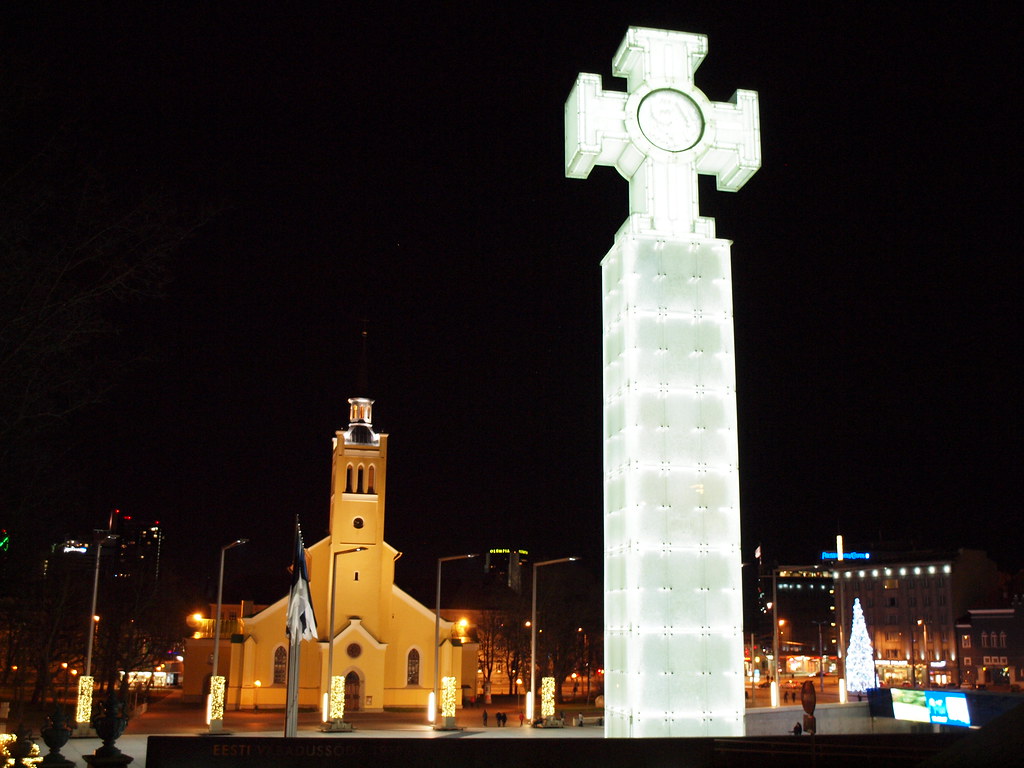
Vabamu Museum of Occupations and Freedom. This uses an interactive audioguide to explore life in Estonia in Soviet times. Outside are 21 of the 100 Suitcases – concrete suitcases with destinations from all over the world – places where Estonians emigrated to. €11, 7 reduced
Charles’ Church. This great stone church is a huge open square with no side aisles and a plain white interior. The pews are elevated on wood plank platforms. The restoration of a mural in the apse is detailed but is only in Estonian.
I then returned to my van and drove out to east Tallinn to see Kumu and Kadriorg Palace.
Art Museum of Estonia (Kumu – Eesti Kunstimuuseum). Features the country’s largest collection of contemporary and modern art including Western, European and Russian art. 100 guest artists – modern art. Classical Estonian art (little struck me but the sculpture). Gustav Klucis (1895-1938), was a Soviet artist interested in propaganda art, and geometrics. Art during the Soviet era, much of which I liked. Two American artists, Tommy Cash, and Rick Owens had some very unusual pieces. €8, 6 reduced
Kadriorg Art Museum. The museum is located in Kadriorg Palace, a beautiful Baroque building erected by Peter the Great. This is an impressive palace outside and in. The exterior is an attractive red/yellow and white trim and the inside has some lovely Baroque rooms with stucco ceilings. The marquetry room was a highlight with scenes circling the upper walls and wood everything. It stores and displays about 9,000 works of art from the 16th to 20th centuries, including a lot of Estonian silver. €6.50, 4.50 reduced
I then drove back to West Tallin to the market and prison before going to the ferry.
Baltic Station Market (Balti Jaama Turg). This is a very modern market with vegies and fruit in a covered open-air area and fish, meat and restaurants in buildings. It is next to a major transportation hub, the Baltic Station.
Patarei Prison. Originally a naval fortress on the Bay of Tallinn for 150 years, it was a feared penal institution in Nazi and Soviet times mostly for political prisoners: politicians (of the 59 held here at various times, 56 died), farmers, business elite, partisans (Defence League and Forest Brothers), and Jews (of 12,500 Jews in Tallinn before the war, 2,000 were held here and only 100 survived the war). Most were sent to Siberian labour camps. The exhibits discuss Communism in detail – 90 million people around the world died in Communist countries during the 20th century – 20 million in the Soviet Union, 65 million in China, and 2 million in Cambodia under the Pol Pot and the Khmer Rouge (¼ of the population). Only Cuba, China, Laos and Vietnam are communist today.
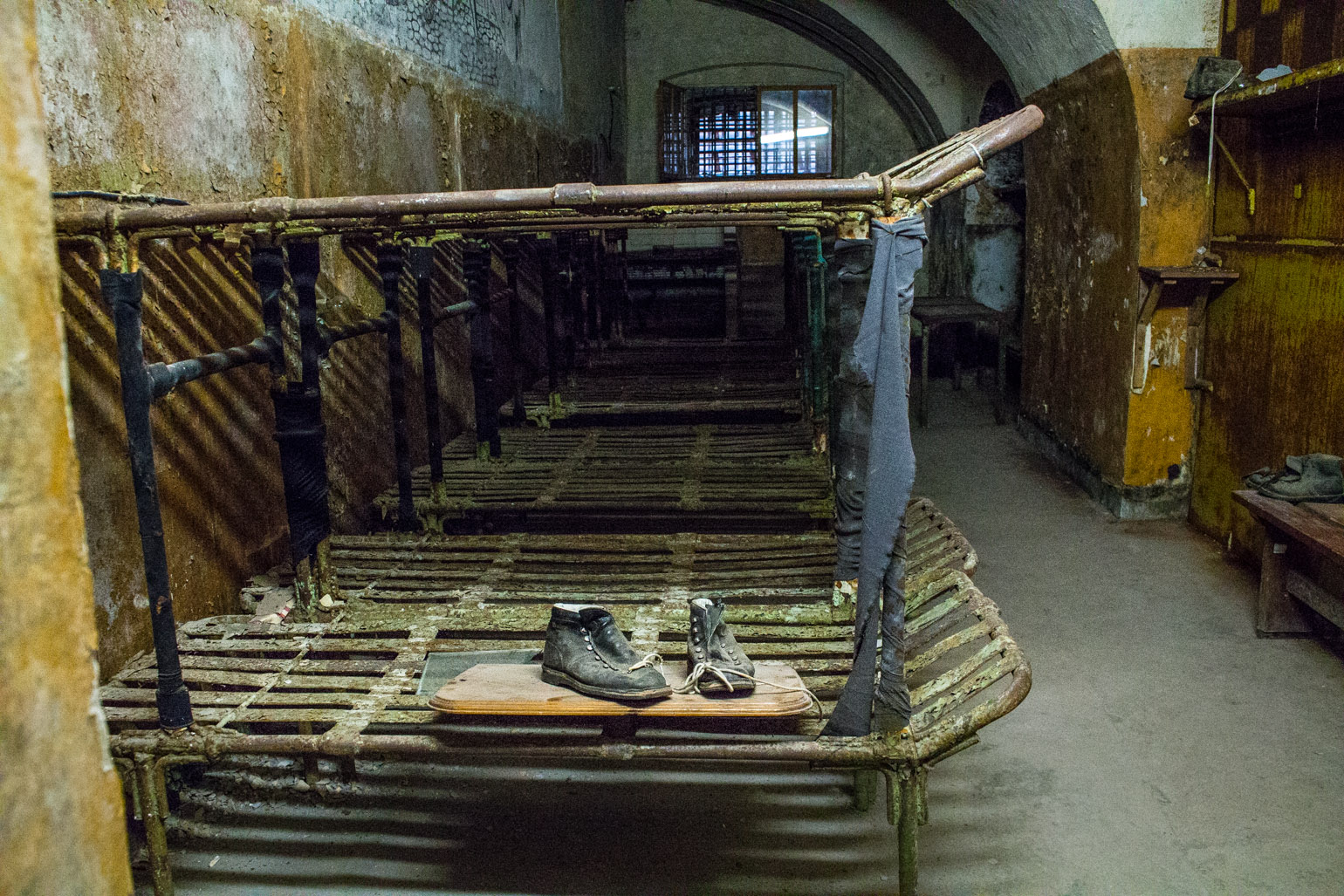
FERRY – Tallinn, Estonia to Helsinki. Finland
Three companies provide ferry services across the Gulf of Finland. www.laevapiletid.ee is a great website that pools all three and provides an easy comparison of times and costs for the particular day you want to cross. I used Eckero Line and booked the day before for travel on July 9. The 18:30 sailing was the cheapest one at €53 for a vehicle and one passenger. This was unbelievably cheap and a perfect time for me. Costs seem to go up the closer one is to your sailing date.
Another advantage of the VW California is ferry costs. At 4.9m long and slightly less than 1.9m high, it qualifies as a car and has the cheapest price. The most expensive cost was with Viking at 6 am for €120.
There is no need to print your ticket. Simply write down your booking number and give it to the check-in booth at the Echero terminal. I had no wait at the booth and luckily moved past all the lines and boarded quickly.
The crossing takes 2½ hours. As nighttime is so short at this latitude, I arrived in Helsinki with a couple of hours of light.
The ferry has only lounge and restaurant seating. There were at least 3 bars and one restaurant (buffet €30). People board and run upstairs to get a seat. I ended up on a narrow stool directly over the stern (arguably the best view on the boat), but could have asked someone to share their table. I had bought a sandwich in town and avoided the ferry costs. There are several video gaming rooms and fast free wi-fi.
FERRY – Helsinki to Tallinn – August 2, 2019
After Turku, I drove for a while toward Helsinki and then searched www.laevapiletid.ee for ferries to Tallinn Estonia. Echero’s trip (€53) at 2:30 was sold out and most other ferries were €89-120, but Viking had a ferry at 10:30 for an amazing €33. I tried to book online but couldn’t, tried phoning but couldn’t connect, visited the Viking website where the fare was €89 and returned to Laevapiletid, sent an email and got the trip. It was hard to believe it could be so cheap and reinforces using Laevapiletid to do all bookings in the north Baltic.
I slept at a gas station without wifi, worked on my posts and had a great 8-hour sleep. The 120km drive into Helsinki was fast averaging over 130 km/hour and I arrived at the Viking check-in at 9:45, loaded and sat on the sundeck writing all this.
The ferry was an uneventful 3½ hours. It had free wi-fi and I was able to get caught up on all my posts.
I returned to Estonia on August 2 from Helsinki. I bought 2 full tanks of Campingaz at Makasport in a mall and started my drive through northwestern Estonia.
Suurupi lighthouses. 28 km west of Tallinn, these two lighthouses (Rear and Front) are along the north coast of Estonia and are leading lights that guide sea traffic in and out of the port of Tallinn from the west.
Front: Built-in 1859, this is the oldest working wooden lighthouse in northern Europe. Surrounded by several buildings, the light itself is in an oddly shaped rectangular 4-story building shaped like a truncated pyramid. It is not a rotating light with a Fresnel lens, but a direct beam that is automatic. Although the light building is government-owned, it sits in a private lot with a fee to enter, but it is simply a stairs and a light. €5
Google Maps tried to take me down a narrow walking path to get here, but there is a good paved road.
I ended up having a long nap in the shade of some big trees here.
Keila-Joa Manor and Schloss Fall Museum. This is a very attractive yellow with white trim, 2-story manor house. In the house is the Schloss Fall Hotel, Cher Ami Restaurant (hours 12-22:00: starters €9-11, mains €15-21, dessert €6) and the Schloss Fall Museum which gives the history of the manor house and tours. The house is full of portraits and period and modern furniture. €8, 5 reduced. Fronting the property is a small river with a waterfall upstream. It is about 15km south of the lighthouse.
Rummu Underwater Prison (Rummu Quarry). In the NM “Bizzarium” series, this was a Soviet prison the Soviets left in 1991, but Estonia continued to use it as a prison until it finally closed completely in 2012 (although the prisoners no longer had to labour in the quarry). The prisoners in Soviet times worked in the quarry, built the long limestone wall around the entire area and created the “mountain” of slag and mining remnants that is riven with eroded channels and the subject of most photographs. The pumps were stopped and the quarry filled with water forming a 2½km long reservoir and entombing all the excavators, equipment and buildings inside the quarry. It was privately purchased in 2015 and the Rummu Adventure Center was created down at the water level with a restaurant/bar, stand-up paddle boards – €15/h, canoes – €20/6h, diving into the underwater prison – €55, snorkelling – €10 and tours of the former prison.
Enter at a gate and pay the €3 entrance fee, then drive down the very dusty road beside the prison wall with guard towers, a razor wire fence and a high cement wall topped with 2 rows of razor wire. In addition to the restaurant in one of the prison buildings with its attractive deck and beanbags, there is a large abandoned 5-story square tower and in the water a building, a small wall and frame for a crane or hoist. Expect a lot of limestone dust.
Koluvere Castle, Koluvere. It has had many owners and has served as the residence of the Saaremaa and Läänemaa bishops as well as a psychiatric hospital in the Soviet era. It was acquired by a Tallinn family who completely renovated it and vacationed here. The building and grounds are well maintained with a fresh coat of white paint, refinished doors, two smart cannons in front of the doors and manicured lawns. It is surrounded by a moat and accessed by a lovely stone bridge but the gate was locked and marked Private. I crossed the dam creating the moat and the very shallow moat on some stones and walked around. Some kids came and fished in the moat. A 30ish man came by and we talked for a long time about the castle and his life.
It was so peaceful and serene that I stayed here for the night, having my first coffee and eating my first cooked meal in almost 20 days. It is surprising but I don’t lose much weight eating just salads.
GO TO Estonia – Hiiumaa, Saaremaa
I returned from Saaremaa on the same day and saw the rest of coastal Estonia before continuing on to Latvia.
PÄRNU
Pärnu Museum. The permanent exhibit was the usual for a city museum – archaeology, stuffed animals and a history of the town from 7000 BC when seal hunting was the economy. The Crusade in 1216 brought writing, Christianity, the Latin alphabet and medieval education plus much more. The temporary exhibit was a photographer that I chose to not pay for. €4, 3 reduced
St. Elizabeth’s Church. Built in 1768, this church has seen better days. All the garish paint is peeling. It had a construction fence around it. Ads for the Parnu Festival from June 1-Aug 31 are held in the church. But it doesn’t appear to hold services.
Endla Theatre. The drama theatre in Parnu. From Aug 23-31, it is presenting a different play every night and over three weekends in September. Only in Estonian.
Pärnu beach. This big beach is both long and deep with fine beige sand. The water in the Baltic is shallow a long way out. Many people were strolling along the wood boardwalks on a Saturday evening.
GO TO Latvia – Riga, Pieriga and Vidzeme (Valmiera, Alūksne)